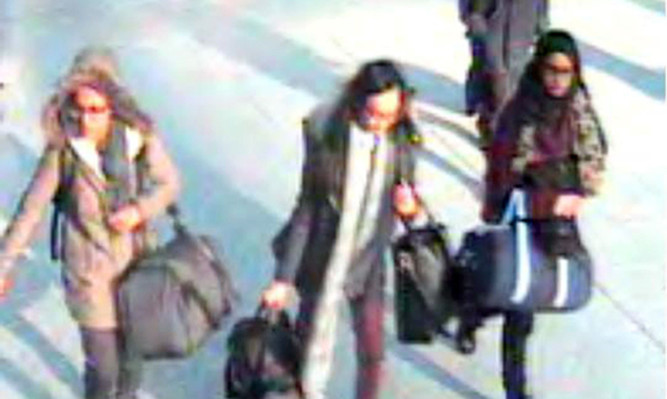
Police top brass have conceded they should have communicated more directly with the families of the teenagers, who have vanished into the terror group’s evil clutches.
They were lured to the wilds of Syria after communicating via Twitter with Aqsa Mahmood, 20, who left Glasgow in 2013 to marry one of the terror group’s fighters. She is believed to have played a key role in radicalising the youngsters.
Police officers visited the girls’ school amid fears pupils were becoming radicalised. They were responding to an earlier case of a teen who fled to link up with the murderous Jihadis.
But incredibly warning letters for the families of seven girls deemed to be at risk, including the three who went on to flee Britain, were given to the pupils themselves.
They were handed to the girls at their school, Bethnal Green Academy, London. They failed to pass the vital letters on sparking anger from their families and contrition from the Metropolitan Police.
Last night Scotland Yard said “with the benefit of hindsight” the letters should have been delivered directly to their parents. The failure allowed Shamima Begum, 15, Kadiza Sultana, 16, and 15-year-old Amira Abase to fly from Gatwick to Istanbul on February 17.
A Scotland Yard spokesman admitted the blunder happened on February 5, when the Metropolitan Police’s Counter Terrorism Command (SO15), held a meeting with seven girls.
He said: “In this meeting an SO15 officer handed letters to each of the girls, addressed to their parents, requesting their daughters’ further co-operation as part of the investigation. We now understand that these letters were not passed on in every case.
“With the benefit of hindsight, we acknowledge that the letters could have been delivered direct to the parents. However, the parents were already aware from the deputy head that the 15-year-old girl had travelled to Syria, all the teenagers were being co-operative, they were all being treated as potential witnesses and there was nothing whatsoever to indicate that they themselves were planning to travel to Syria.”
The families of the schoolgirls are fuming. Abase Hussein, father of Amira, said his daughter would still be at home if he had seen the police warning.
“If we knew, this wouldn’t have happened,” he said. “We would have stopped them. We would have discussed it and taken their passports from them. This wouldn’t have happened.”
Halima Khanom, sister of Kadiza Sultana, added: “We wouldn’t have been here today doing this if we’d got that letter and known what was going on.”
Last month it emerged Aqsa Mahmood, who enjoyed a privileged upbringing in Glasgow, may have been involved in radicalising the girls. On February 15, a message was sent on social media site Twitter from Shamima Begum to Mahmood, suggesting they were in regular contact. The revelation provoked a furious reaction from Ms Mahmood’s family, which said: “You are a disgrace to your family and the people of Scotland, your actions are a perverted and evil distortion of Islam.”
Islamic State has 46,000 Twitter accounts which it uses to recruit and radicalise people across the globe.
The terror organisation has been laying waste to Iraq’s cultural and historical heritage by bulldozing ancient sites.

Enjoy the convenience of having The Sunday Post delivered as a digital ePaper straight to your smartphone, tablet or computer.
Subscribe for only £5.49 a month and enjoy all the benefits of the printed paper as a digital replica.
Subscribe